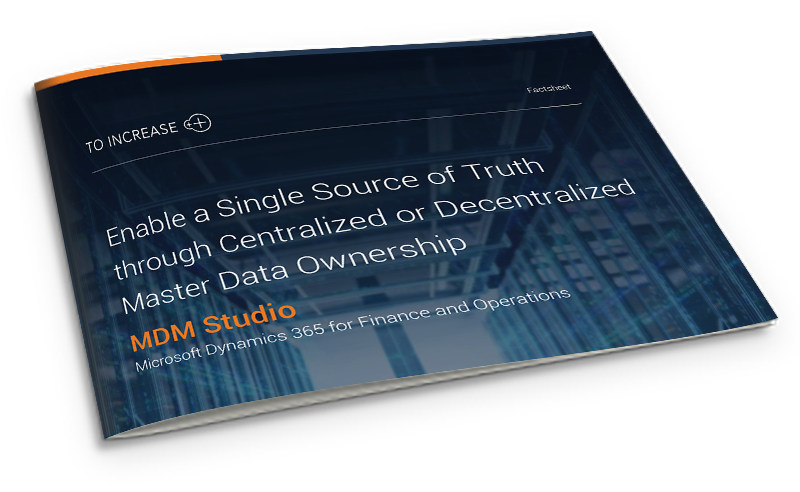How confident are you when it comes to the quality of data within your Microsoft Dynamics 365 ERP?
According to a report by KPMG , 56% of CEOs are concerned about the integrity of the data they are using for decision-making, and 45% believe that a lack of quality customer data hinders the depth of their customer insight. Imagine sending an important customer email to the wrong email address, making a product launch decision based on inaccurate data on buyer preferences, or being unable to access a list of your top 100 customers because data is scattered across multiple systems. Imagine if this happened to you.
If you cannot master your master data, it can result in incorrect decisions, loss of credibility, and a waste of time and money.
In our experience at To-Increase we’ve had so many people ask us this question "When is the best time to implement a master data management (MDM) solution?"
It’s easier to start early on in your digital transformation journey than implement it later. Although the investment is substantial, when done right by following best practices, it's much easier to manage your master data. The result for you is opportunities to generate more revenue.
We’ve created a solution, Master Data Management Studio, to make sure that you don’t make mistakes in managing master data, but this blog is not about our solution. This blog is going to help you if you are implementing MDM with any solution.
5 MDM Implementation Best Practices
Are you considering implementing MDM in your Dynamics 365 ERP? Then, read on to know the best practices for MDM implementation.
1. Build your business case for MDM
One of the top reasons for the failure of an MDM initiative is a missing business case. Your business case should answer the why, how, and who aspects of MDM implementation. Here are a few more best practices to follow to build a better business case.
- Connect your master data projects to your business strategies, goals, and objectives so that the benefits are clear.
- Reach out to business users to understand how data is used in your organization's functions and processes.
- Decide when and where to start, and don’t forget to plan for data governance.
- Identify and prioritize business challenges and data issues and be clear on the organizational objective of MDM implementation.
2. Identify your stakeholders
Identify stakeholders and get a senior executive to act as the sponsor or champion for MDM implementation. Stakeholder alignment is a vital part of MDM implementation. The champion or sponsor is actively invested and involved in the implementation process and communicates with all the stakeholders. This ensures that the goal of your MDM implementation project is aligned with the company's objectives.
In addition to stakeholders, you also need a project team that is empowered and held accountable for meeting milestones and completing goals. Get inputs from each department within your organization for a worthwhile MDM project, as every department uses data in one form or the other.
Here’s a list of potential stakeholders for MDM implementation:
- Senior management
- Business users
- Data stewards
- Application owners
- Information architects
3. Follow a clear implementation strategy
Approach your MDM implementation with a well-researched plan. Do not ignore scalability and future design considerations. Many of you might wonder if it would be better to start with one domain of master data at a time or focus on multiple domains. I would say this entirely depends on your business challenges, data pain points, and the timelines within which you must solve the challenge.
For instance, we had a prospect with a failed ERP implementation because of issues with master data. Since they faced challenges with product data, we advised them to follow a phased approach for MDM implementation and focus on clarity of product data as the primary goal of the implementation project. But this may not always be the right approach. Some organizations may need to focus on multiple domains (e.g., customers, products, and rental objects) as it becomes critical to solving their business challenges.
In your Dynamics 365 ERP, you can use MDM solutions to focus on data distribution, data entry, data quality, or data security, or you can implement all of them together. It doesn't matter if you start with one or the other or do it all together. What's more important is that you are clear on what's critical for your business and follow the correct process.
4. Focus on business processes
It is key to define the correct business processes for creating master data. When defining the process, you must take data governance into consideration. During data entry, how can you ensure smooth processing or speed up data entry?
Often, we see that multiple disciplines contribute attributes to a single master data record. A workflow solution is recommended where multiple users will be guided to provide their part of the master records. Each user gets a subset with relevant fields and workflow steps assigned to them.
Within our MDM solutions portfolio, we are currently developing a new solution for Dynamics 365 Finance and Operations called Data Entry Workflows. It allows you to configure workflows to manage the creation, updates, and approval of master and reference data where user collaboration is ensured.
5. Plan for data governance
MDM implementation cannot be successful without proper data governance. You can compare data governance to the blueprint of a building. It provides the framework for creating policies, standards, and processes to optimize the value data can provide to your organization. Managing master data and data quality are dynamic processes that require constant monitoring to meet the organization's goals. Data governance aligns the essential elements, mainly people and processes, that can contribute to the success or failure of MDM implementation.
Can you implement MDM without data governance? No, you cannot do MDM without data governance. It's like asking if you would build a house without a plan. Now that would be a recipe for disaster…not just for you, but the builder too. Similarly, MDM implementation will fail without proper data governance.
How can you get started with MDM implementation?
Following best practices sounds like a great idea, but what if you do not have the time or the resources to put an MDM implementation plan into action?
The only advice I have would be to start small. Don't wait till your business process breaks. If you wait, then the chances are that you will incur an exponentially higher cost. Identify one or two areas where a lack of quality data is causing friction and start working on a plan to resolve that.
And relax, you are not going to solve it in a day. You have to focus on what you do best and leave the task of implementing MDM to the experts. The worst place to be is on the wrong side of a good idea, and MDM implementation is a good idea.
Our MDM Studio can empower your data stewards to manage master data within D365FO and D365F&SCM. Watch this video to find out how the MDM Studio can help you map your global, regional, and local data within Dynamics 365.
If you are a small company that has hundreds of contacts, you can probably put together a manual approach to getting your systems to leverage a single source of truth. But if you are a medium to large business you are going to need help. You are going to need someone to do an MDM implementation. Otherwise, you will have thousands and thousands of hours of work on your hands that you don’t have the ability to waste time doing.
You may not need our solution if you are a very small business. But if you are not, you might want to get more information on our solution, the MDM Studio, by downloading this factsheet.





